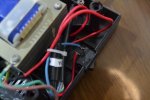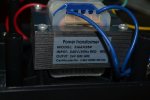Just received my soldering station from HK. It took 9 days via EMS. I'll do a quick overview on this thing. Excuse the not-so-good pics.
Everything out of the box. The base unit is sturdy enough. The iron holder feels very cheap. Its mostly made out of plastic except the sponge holder which is aluminum. The iron itself doesn't fit in snugly and the nut contacts the plastic on the holder. It came with a sponge but I'm using a brass cleaner.
The iron feels good and its light too. The rubber grip is soft and comfortable to use. The cord is a bit stiff and short, though. I've changed the tip to a genuine Hakko chisel tip.
Here is the circuit board. It looks like the typical cheap chinese made boards. I didn't bother with the other side because the pics suck. Soldering quality is okay but there are some hand soldered joints that don't look too good.
HK sent me the 240V version. The transformer is a little small, I would say.
Someone wasn't paying attention while soldering. They opted to use an inline fuse holder instead. Its hard to see but the earth wire is soldered directly to a tab on the transformer. Solder quality is horrible and it looks like its a cold joint.
I've tried to do some soldering and its adequate for most pcb work. However, I had to increase the heat when soldering large components and large gauge wires. Overall, the quality is okay. Not much to complain about since its just a little over $15 for the unit.
I have a question though. The transformer is rated at 240V @ 50Hz. The mains here is 220V @ 60Hz. I assume I would get a lower power output since the voltage is also lower? And what would the different frequency do?








